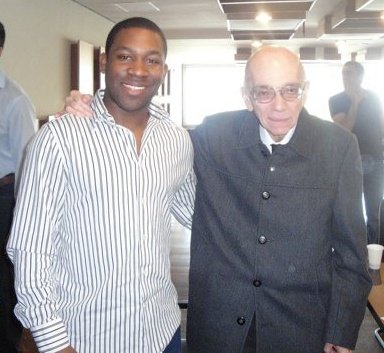Students from the El Sistema Folk Music program at the nucleo in San Juan De Los Morros peform for us. This didn't take place during our time in Mérida. San Juan De Los Morros is about 2 hours from Caracas. I put up this video because it was a simply a great performance. How great would it be to have music from different cultures be played at El Sistema programs in North America? Since North America is such a melting pot of cultures, the sky's the limit in terms of the type of music.
Another performance from San Juan De Los Morros. Watch these two blind students play a snare drum duet for a crowd of about 500+. What I really like about this video, besides the playing, is to see the students in the background so excited to be watching and then applauding at the end. I noticed this at all the nucleos I've been to. All the students at the nucleos love to watch the special education students perform. I'm sure they appreciate how much more difficult it is to play music without seeing or hearing.
This video is of "El Coro De Los Manos Blancos" or "The White Hands Choir". Basically the concept is that students with hearing deficiencies participate in a choir by using sign language instead of singing. In order to keep the beat they use movements such as dancing or swaying side to side. When the White Hands Choir performs they do so at the same time as another choir in which the participants actually sing the music. So there are two conductors conducting at the same time, one leading the sign language for the White Hands Choir and one leading the singing choir. The result is what you see in this video taken at San Juan De Los Morros near Caracas. I should point out that the White Hands Choir is open to any student, not just the ones with hearing deficiencies.
This video is from the city of Mérida nucleo. In it we get to see how the special education teachers work with students who have hearing deficiencies. For example, in order to teach violin, the teachers color code the four strings with bells. Each bell is a different color and has the same pitch as the strings on the violin. From there I'm not sure how they get to more complicated stuff, I missed some of the explanations because they were in Spanish. I'd appreciate any insight. But suffice it to say that this is painstaking work and takes a lot of time. I should point out that several of the special education teachers at the Merida nucleo are students in the regular music program who give their time to work with the kids that have special needs. Another excellent opportunity for peer-to-peer mentorship.
This is the choir from the Santa Cruz De Mora Nucleo in Mérida State. The song is called "Himno A La Paz, or Hymn To Peace and it's by a Venezuelan named Jose Apolinar Cantor. My eyes got watery while watching this performance and I don't even understand what they're saying!
Here's a video of my fellow Abreu Fellow Jonathan Govias conducting the end of Beethoven's Egmont Overture during one of the rehearsals of the youth orchestra in the city of Mérida nucleo. The nucleo director wanted our roles as fellows to be hands on so he had us participate in some of the rehearsals. From my seat in the bassoon section I took a little break from playing to record this clip.
This video is from the string orchestra class at the city of Mérida nucleo. In it we catch a glimpse of perhaps the next Gustavo Dudamel. The teacher simply asked who wanted to come up and lead the orchestra through an exercise and this kid volunteered. If you're a music student in Venezuela and you want to conduct, you will have an opportunity. Here, as soon as a student can, he/she is given the responsibility to lead his peers. We've probably seen around 30 or 40 performances in Venezuela and I'd guess that the average age of the people conducting the performances is somewhere between 20 and 30, with several under 25. How is Dudamel conducting all this great repertoire all over the world at the age of 28? People here tell me that he started conducting orchestras when he was about 11 years old so maybe that's the answer. Look out for a Venezuelan maestro in a concert hall near you because believe me, they start them young and they're coming.
I capped off my stay in Mérida by teaming up with some of the bassoon students and the bassoon teacher to play a little chamber music concert. In this video we play two movements of a well-known bassoon quartet (well-known among bassoonists, that is) called Le Phoenix by Michel Corrette. Thank you to bassoon professor Ruben Duran and his students, Jorge, Emiro, Marco, Leonar and Claret for a great 10 days at the Mérida nucleo.

No comments:
Post a Comment